Note: This website was automatically translated, so some terms or nuances may not be completely accurate.
Seven Key Points to Know About Smartphone Marketing
Smartphones have become inseparable from our lives in the past decade. In advertising and marketing, they are now an indispensable touchpoint with consumers. This article introduces seven key points marketers should know about smartphone-based marketing, covering essential concepts and the latest trends.
Table of Contents
▼1. Smartphones and Daily Life
▼2. Optimizing Smartphone Usage Through "Self-Curation"
▼3. Smartphones: From Response Media to Attractive Media
▼4. User Behavior Shifts from "Skipping to Scanning"
▼5. The Existence of Aftermarket Sensors
▼6. Personification of Media, Behavior of Content
▼7. Key Purchase Factors: "Knowledge = Interest" and "Conviction Over Desire"
1.Smartphones and Daily Life
1.1. Adoption Rate: Approximately 80%
The smartphone era began with the iPhone's debut in 2008. Over the past eight years, smartphone penetration has rapidly grown to around 80%. According to the Ministry of Internal Affairs and Communications' nationwide "Communication Usage Trends Survey," smartphone usage among people in their 40s surpassed PC usage in 2015. Smartphones are becoming the number one device not just for young people, but for middle-aged individuals as well. However, the growth in penetration rate has slowed in recent years, signaling market maturity.
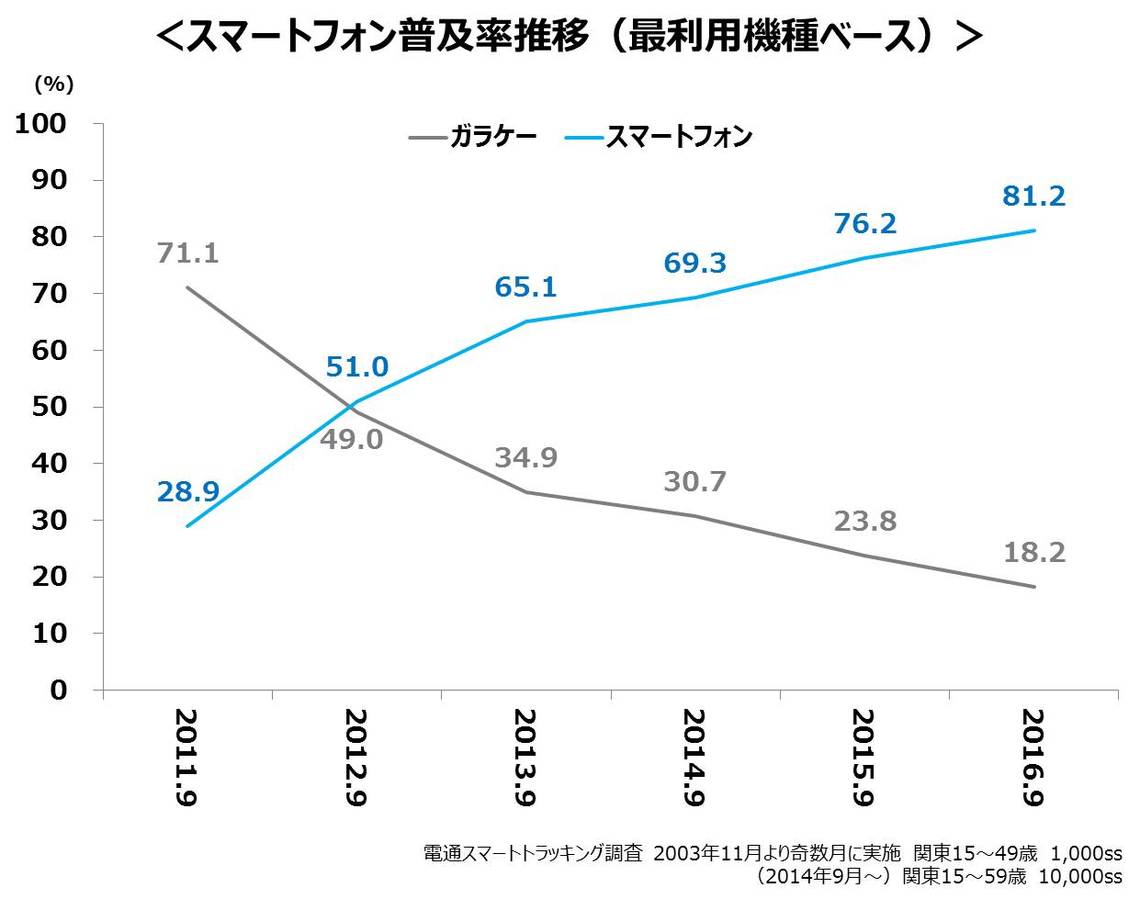
1.2 iPhone and Android are split evenly
In terms of OS market share, iOS and Android are evenly split. However, a notable characteristic is the extremely high iPhone user rate among women in their teens and twenties. This demographic also uses smartphones very heavily. Since the access numbers for many sites and apps show a higher iPhone rate than the actual OS share, there is a tendency to prioritize iPhone when considering smartphone communication.
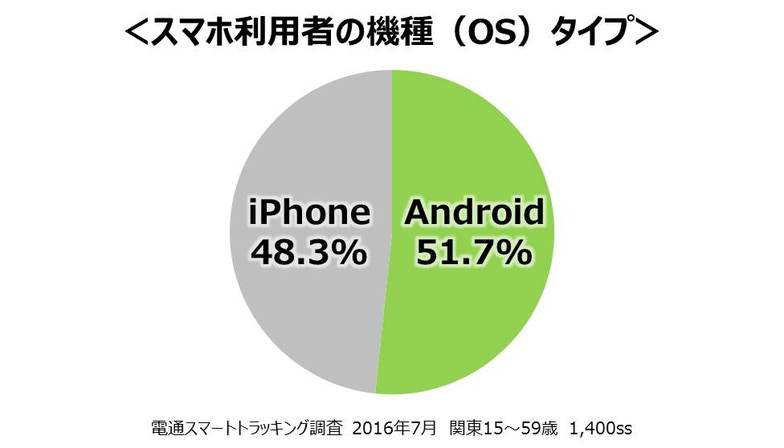

1.3 Smartphones are communication & information gathering media
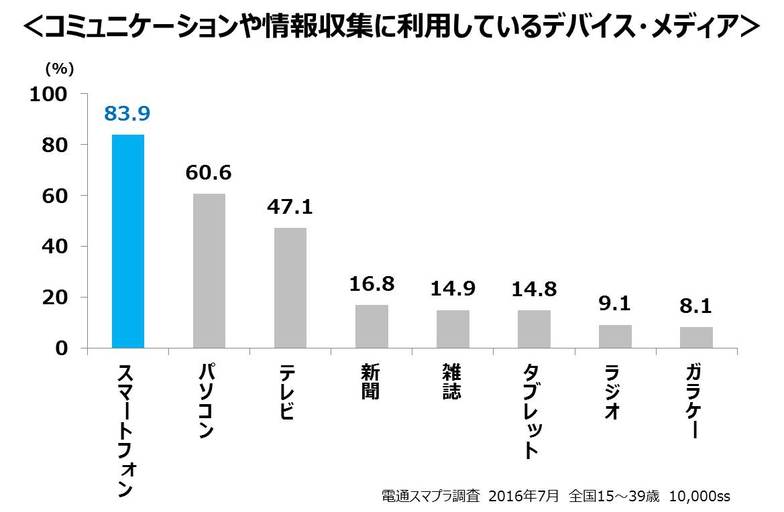

Smartphones are the number one device and information medium used for communication and information gathering. Furthermore, when focusing solely on information gathering, smartphones account for two-thirds of usage. As a device enabling information gathering anytime, anywhere, smartphones have become completely integrated into daily life, particularly among teens.
Women tend to prefer simple, intuitive ways to enjoy everything, so they often complete tasks solely with their familiar smartphones. In contrast, many men use both PCs and smartphones. Men show a tendency to choose the optimal device for each purpose—playing games on dedicated consoles, listening to music with high-resolution, high-quality headphones, etc. This suggests PCs, with their larger screens and keyboards/mice, serve specific purposes better than smartphones. Women tend to use their smartphones for anything they can do on them, while men use their smartphones if they're the best option. However, for both, smartphones are completely central as information gathering devices.
1.4 Usage is "personalized"
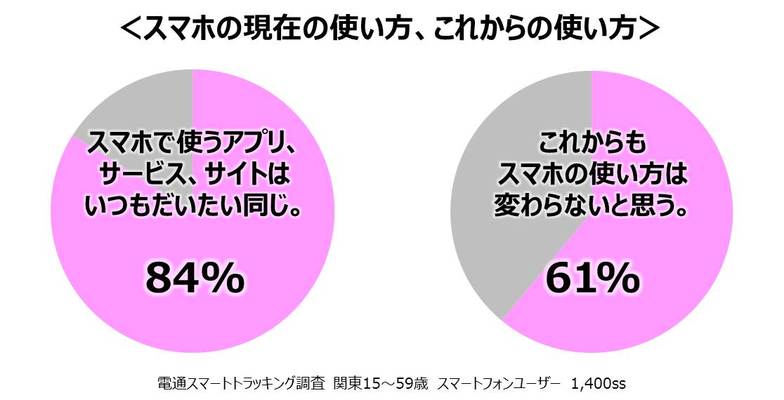
Over 80% of respondents said their smartphone usage is "always pretty much the same," and about 60% feel "this usage pattern won't change going forward." In other words, smartphone usage is becoming fixed. Furthermore, even though each person's smartphone usage differs, I describe this fixation as "individualization" to convey that each style is beginning to solidify. Many people likely recognize the behavior of reaching for their smartphone during their morning commute or whenever they have a spare moment, instinctively launching their favorite apps. However, "usual apps" vary greatly from person to person. For example, some might prefer economic news, while others seek hobby-related information. Still others might favor games or manga over news. While the habit of launching familiar apps on their smartphone is the same, the specific content differs for each individual – this is "individualization."
2.Optimizing Smartphone Use Through "Self-Curation"
2.1. Growing Awareness of Data Usage Concerns

Have you ever experienced your smartphone data plan exceeding its limit toward the end of the month, resulting in slower connection speeds? Surveys show over half of smartphone users are "concerned about data usage." This issue became apparent with new pricing plans introduced in 2014. While 7 gigabytes was the standard data allowance before, lower-capacity, cheaper plans like 2GB or 5GB began to proliferate. As a result, users could only utilize about half the data capacity they were accustomed to, leading to increased awareness about using Wi-Fi and minimizing unnecessary data usage. This situation may resemble the early 2000s when the phrase "data charges are expensive" became commonplace. Furthermore, while the introduction of 20GB/month plans by major carriers in September 2016 may potentially shift awareness going forward, it will likely take some time for a significant overall change to occur.
2.2 Services Seeing Growth: Curation and News

Compared to data from a year and a half ago, usage rates for most content—games, music, videos—have declined. Conversely, curation sites and news apps, which have seen increased usage, are key because they "aggregate" information. Previously, users had to search for scattered information themselves, but they've intuitively begun to realize that content aggregating desired information is highly efficient. Since smartphones are primarily tools for communication, the conscious effort to minimize unnecessary data consumption for non-communication or non-hobby purposes is likely accelerating this trend.
2.3 Another already widespread storage concern
The increase in iPhone users has solidified concerns about internal device storage capacity. Over time, photos and other content steadily consume internal memory, reducing available space. Recently, larger app sizes have also impacted internal storage. Among young women, a demographic with high iPhone adoption, deleting unused apps has become a habitual practice to preserve storage and maintain a smooth user experience. It's not uncommon to see someone with only one full home screen of apps. For heavy users, organizing apps and ensuring they know exactly where everything is—creating an environment that makes daily smartphone life comfortable—has become second nature.
<High School Girl's Home Screen>
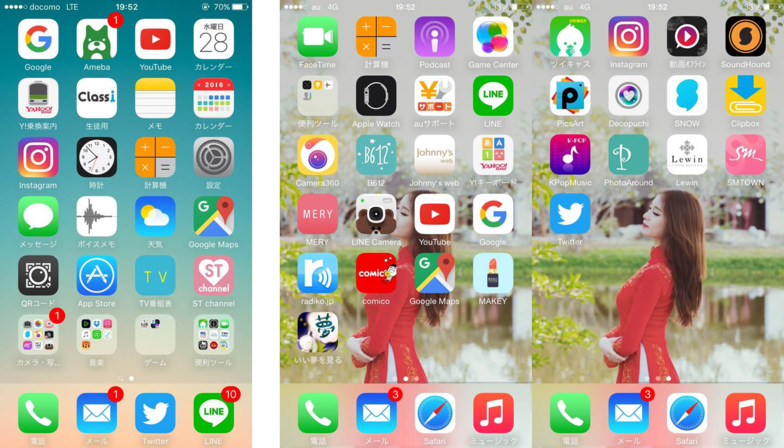
<College Women's Home Screens>
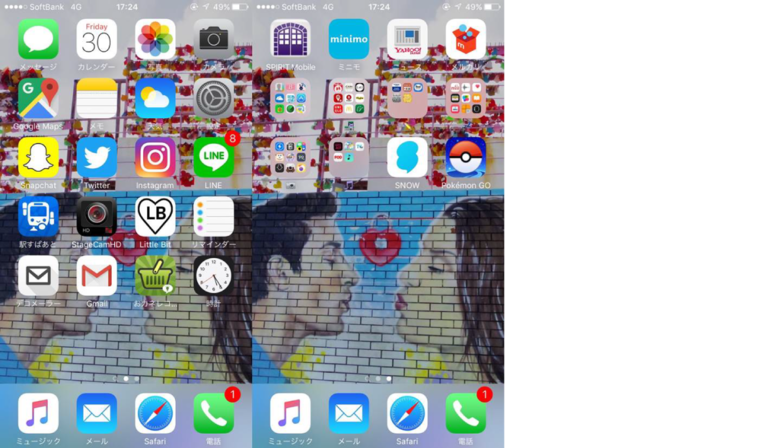
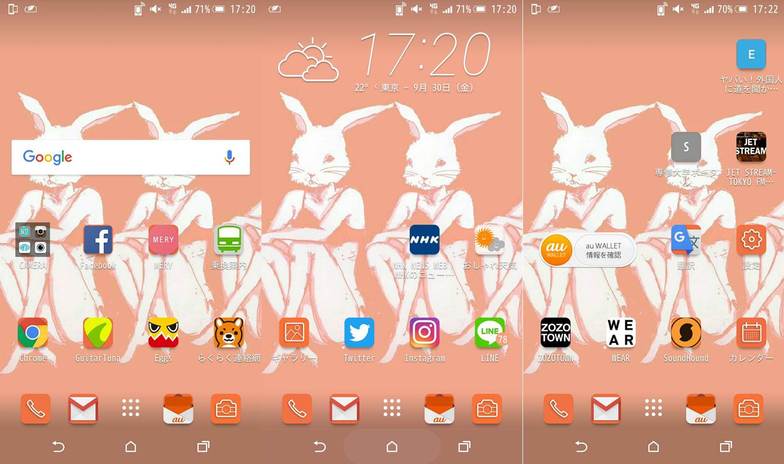
2.4 Self-Curation
While it's natural to find curated content comfortable, we're also seeing a trend where individuals are starting to curate their own smartphone usage. Previously, people might try various interesting apps or games, but since they often stopped using them, they became reluctant to adopt new things—a phenomenon of "personalization" (see 1.4 above). While this could be seen as a rut, it also signifies that people are finally learning to use their smartphones in a way that suits them best and feels uniquely their own.
Personalization = the comfort of one's personal smartphone environment.
It's about building an environment that offers sufficient comfort, discovery of new information, and the ability to maintain good relationships with friends. I call this "self-curation."
3.Smartphones are shifting from Response Media to Attractive Media
3.1 The Smartphone Swamp
Getting hooked on content is often called a "quagmire," and I think smartphones are a kind of quagmire too. When something catches your eye on a smartphone, it usually has a link attached, allowing you to check the content with just one tap. Furthermore, the appeal is often summarized, and you can immediately see the content itself or related images and videos. This frequently leads to the path of "I was curious, I tapped, and before I knew it, I was hooked." Even if it doesn't go that far, the mere fact that tapping instantly reveals whatever piqued your interest means the smartphone itself has become a shallow swamp.
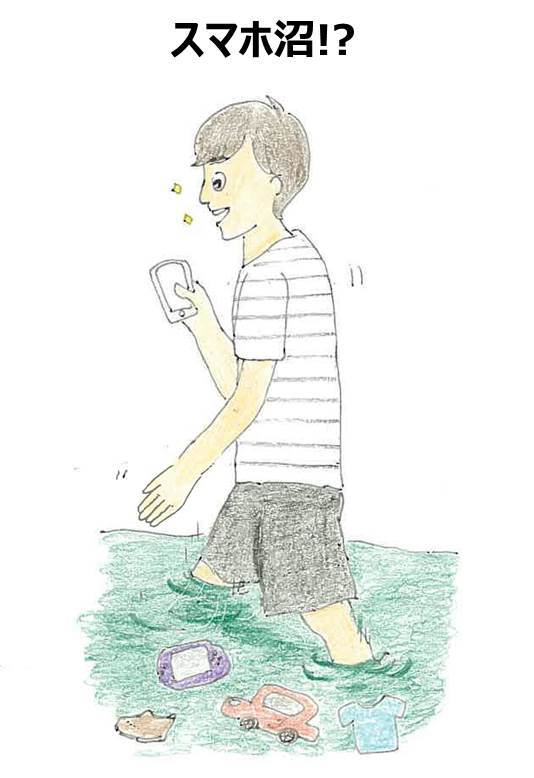
3.2 From Search to Discover

In the feature phone era, the primary behavior pattern was noticing something that caught your attention (Attention) through TV or conversations with friends, then looking it up online (Search). Back then, the mobile marketing industry referred to feature phones as Response Media, where curiosity manifested as Search. However, as smartphones became central to daily life, people could learn about various things with just a tap, without needing to search. When users find interesting information on their favorite sites or apps, they can seamlessly transition to other sites for deeper insights and quickly return to the original site. The proliferation of sites and services that efficiently deliver content matching individual interests has led to self-curation, where users focus on a narrow set of sites and services. This has fostered a "Discover" cycle within daily smartphone usage.
3.3 Attractive Media
Through smartphone self-curation, usage is optimized and personalized. As described in section 3.2, this creates a Discover cycle within users' lives, where they continuously transition between sites to gather information. Furthermore, media itself is evolving. It's shifting from Response Media, where user reactions (like Search actions) reflect their interests, to Attractive Media. This new form draws users into a "rabbit hole" of content, starting from a single intriguing piece of information, without requiring conscious action. Smartphones have become a medium where users can encounter things that catch their interest even with daily routines, and where they can quickly learn more about things that interest them without needing to actively search.

3.4 Search is KPI
As user actions on smartphones increasingly start from search, the meaning of search itself is evolving. In fact, comparing users who searched for a brand versus those who didn't reveals that searchers show significantly higher purchase intent and concrete consideration rates. On smartphones, users can find detailed information about most things that catch their interest without searching. Therefore, services or brands that prompt active, conscious searches gain a certain level of mindshare. Consequently, the value of search behavior within the consumption process has clearly increased compared to before. Utilizing "Search" as a KPI to measure interest and purchase intent is effective.
4.User behavior shifts from "Skip to Scan"
4.1 Information skipping ⇒ Exploring new interests
Amidst information overload, we often describe interactions as "skimming past" content. However, most media engagement fundamentally occurs to seek out information of interest. Furthermore, on smartphones, the rise of self-curation—focusing usage on preferred media and services—has created a positive spiral. Users are constantly exploring their own interests and passions on their smartphones.
4.2 Scan: From Ear to Eye Era

When scrolling through a smartphone screen, the moment your finger naturally pauses on something interesting is called a "Thumb Stop." While the specific points of interest vary—like posts or photos from people you follow—what's noteworthy is that for most people, their eyes "naturally linger." In the past, information primarily came from TV or people talking. As the phrase "hot off the press" suggests, the focus was on gathering information through hearing. With smartphones replacing those methods, perhaps our ears have become less active while our eyes have evolved.
We'll call this behavior "Scanning."

4.3 The Reality of Scan
There are photos or texts that catch your attention unconsciously, making you think "Ah!" rather than consciously thinking about them. You've probably had experiences where your eyes were drawn to things you instinctively felt were "beautiful" or "interesting," photos of someone you find attractive, or pictures of your favorite foods. Similarly, the names of companies you belong to or sports teams you support are recognized more as symbols (shapes) than text, making them easier to notice.
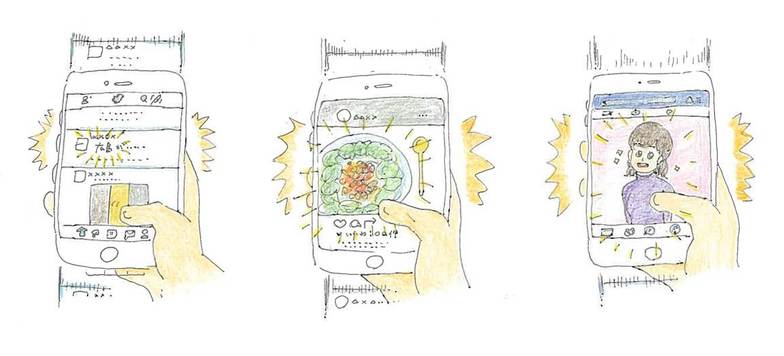
When looking at a smartphone screen, things that catch your attention appear one after another. However, we don't read and understand text line by line, extracting what's necessary. Instead, we possess the ability to instantly identify what matters to us within feeds filled with a mix of text and images.
5.The Existence of Retroactive Sensors
5.1. Good sense is the sensitivity of the Sensor
Catching the eye ⇒ Sensor activation via scanning
Among the vast information scanned, our eyes only catch what interests us because a sensor exists there. Even in the recently popular IoT devices, scanning and sensors operate as one, driving innovation. For example, robots like Pepper scan information with cameras and microphones, which sensors instantly identify. AI then understands, judges, and reacts. Drones and autonomous vehicles also use Scan and Sensor to identify people and hazards, with AI making judgments and controlling actions. Similarly, when people view their smartphones, they Scan the screen with their eyes and identify content using their sensory perception as a Sensor, causing their eyes to linger. Scan functions integrated with the Sensor.
People have long been described as having "good sense," meaning they possess high information sensitivity and can notice new things or trends likely to catch on. Historically, due to high information dissemination costs, information typically flowed from highly sensitive individuals to less sensitive ones. However, the proliferation of smartphones and social media has enabled anyone to easily share information, ushering in an era of diversified values. Going forward, it's becoming necessary to activate the sensors of each individual, not just specific people, which is why we are focusing on these sensors.

5.2. Five Types of Sensors
The sensors we possess can be broadly categorized into five types.
● Instinctive Sensors
Instinctively reacting to things like noticing photos of delicious food when hungry, the type of person you're attracted to, or your favorite color—not through logic, but instinct.
● Hobby-Based Sensor
Reacts to information related to personal hobbies, such as favorite artists, baseball teams, or anime characters.
● Seasonal Sensor
Reacts to seasonally heightened engagement topics, like Halloween cosplay, cherry blossoms during hanami season, or feeling drawn to beach photos before summer vacation.
●Trend Sensor
Reacts to things trending around you or your personal obsessions, regardless of the season.
● Imprinting Sensor
Responds to information intensively broadcast over a short period, such as TV commercials, which becomes naturally ingrained.
5.3. Key Points for Capturing Sensors
There are three patterns to activate these Sensors.
Pattern ① Direct
A pattern where consumers react directly to the product itself or its benefits. Instinctive, Hobby, and Seasonal Sensors activate through this pattern. This applies when consumers have a high level of interest in a product category or brand, when the product matches a problem they are facing, or when they are compelled to use the product or service immediately.
<Direct Example 1>
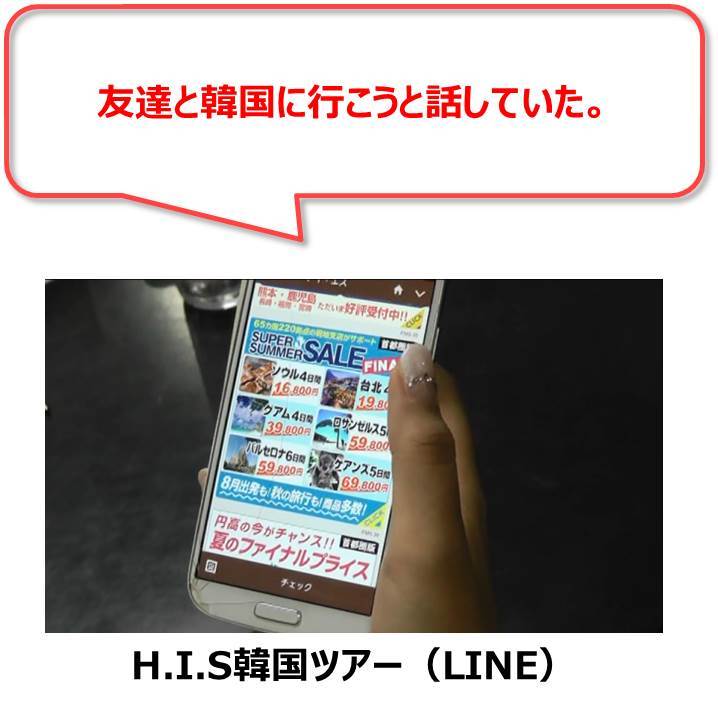
<Direct Example 2>
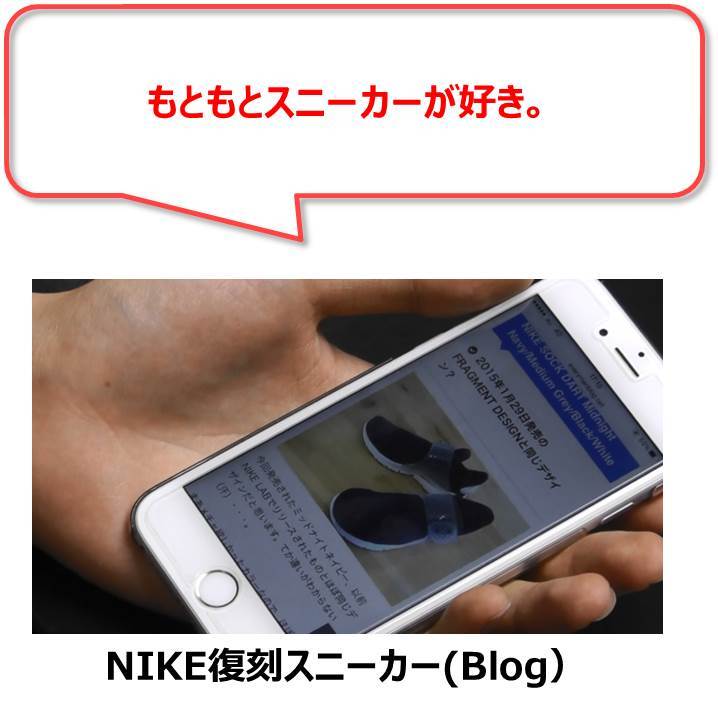
Pattern ② Indirect
For targets unresponsive to direct approaches, this pattern uses different interest sensors to spark engagement, activating instinct-based or seasonal sensors. Specific examples include capturing attention with beautiful photos or approaching from a different angle using information from people close to them or those they admire.
<Indirect Example 1>
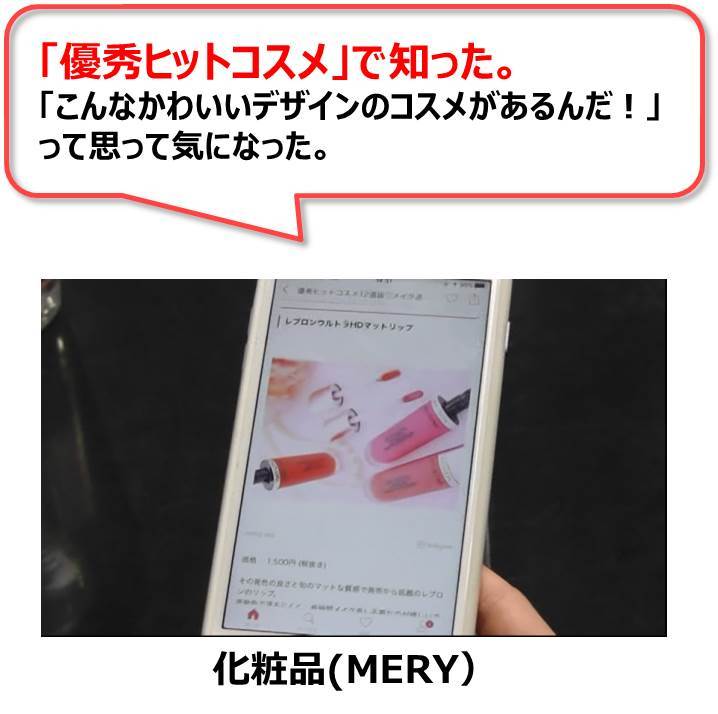
<Indirect Example 2>
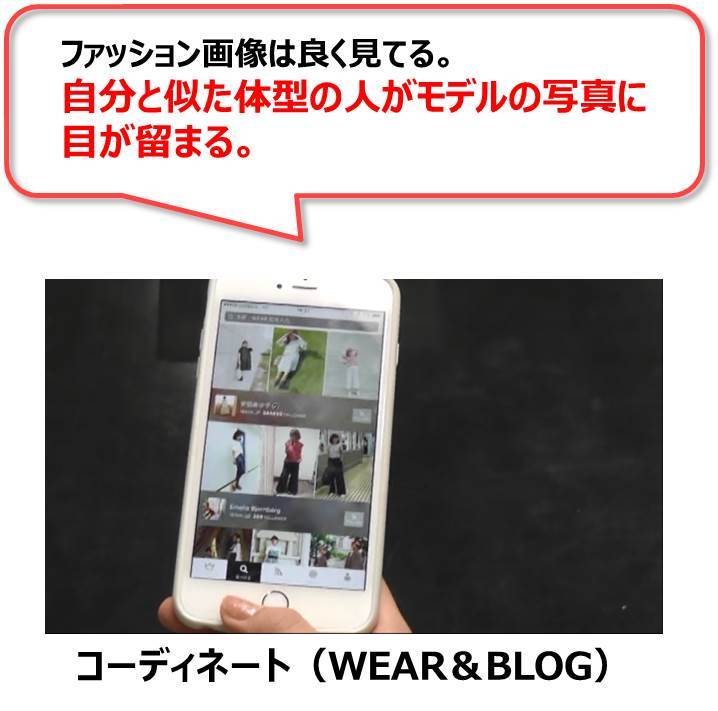
Pattern ③ Preparation
A pattern where coupons or events are announced to targets that can be contacted individually, such as email newsletter subscribers, to trigger Sensor reactions. This pattern also includes cases where mass TV commercial placements imprint product names into imprint-type sensors for smartphone reactions, or where strategic PR creates a buzzing atmosphere around the target, activating topic-type sensors.
6.Personification of Media, Behavior of Content
6.1 The Chaotic Evolution of Technology
<The Communication Domain Up to Now>
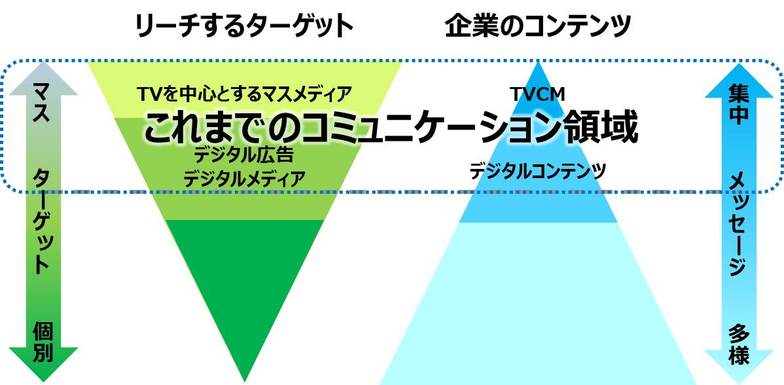
<The Future of Communication>
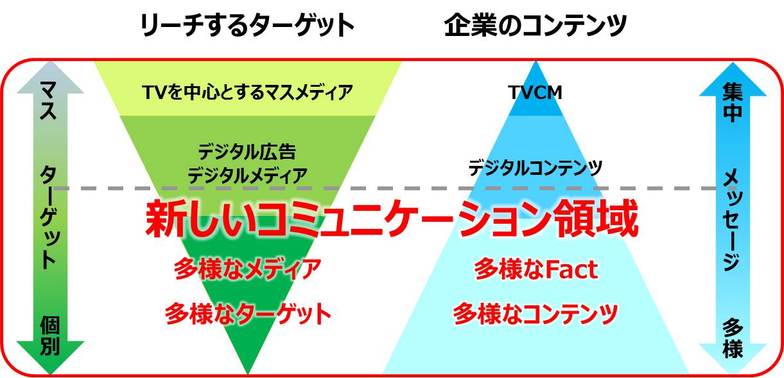
The evolution of marketing technology has expanded the communication domain. It's no longer just about conveying reasonably large facts to a certain volume zone. Now, it's possible to execute strategies that segment both the facts and the targets based on interests and preferences. However, in reality, truly one-to-one communication is difficult from a content production perspective. Currently, the norm is generally limited to optimizing banners and digital ads for each segment.
While the possibilities for marketing communication have increased, the sheer number of tools available—with their diverse variations and functions—has grown to the point where it's unclear how to effectively utilize them. The chart below, known as a "Chaos Map," illustrates this complexity: numerous players offer a wide array of services, creating an extremely intricate landscape.
<Marketing Tools Chaos Map>

6.2. Media Has Become More Niche
When tailoring content as a communication strategy, we recommend thinking first in terms of media platforms rather than individual users. This is because smartphone usage has become highly personalized through self-curation (see section 2.4 above). Consequently, popular media platforms have narrowed significantly. Marketers now need to understand each platform's characteristics and its specific target audience to effectively leverage them. Furthermore, communication on smartphones requires greater attention than other devices to tailoring (changing) the facts communicated, adjusting how content is presented, and modifying messages according to the specific media platform.
6.3. Smartphones are communication tools
While TV is fundamentally a passive viewing device, smartphones are inherently tools for conversation and connection. Users unconsciously engage with them as communication tools. This was true even in the feature phone era and has become more pronounced with smartphones. During the peak of feature phone mobile marketing, the theory was to provide content that sparked communication. With smartphones, communication tools like messaging apps and SNS now function as media platforms themselves. Consequently, consumers approach media with the same mindset as when communicating with people. Understanding this point is crucial for achieving results in smartphone marketing.
6.4 Policies Held by Instagram Influencers
Instagram, a platform noted for launching trends, features influencers known as Instagrammers. What sets Instagrammers apart is their emphasis on authenticity in their posts, prioritizing "how true to themselves they are" over mere coolness or cuteness. While Twitter naturally reveals personality through text (thoughts), Instagram's uniqueness lies in expressing character through personal photos. As users engage with this media-ified personal content, they increasingly perceive personality even in mainstream media.

6.5. Media Needs Human-Like "Personality"
Take MERY, which has many young female users, as an example. With its concept of "things you can do right now to be cute tomorrow," it has achieved a status akin to a special friend for its readers. Its content is characterized by conversational, relatable language and frequent use of girly expressions like "smooth to the tips" and "calculated cuteness."
Furthermore, rather than using models or actresses, it employs curators who share the same perspective as its users. These curators post articles designed to resonate with readers, creating an approach akin to chatting with a friend.
Within each media outlet, editors and curators consciously consider how they are perceived, building a distinct character for the platform through objective posts. As a result, readers increasingly perceive a distinct personality (character) in each media outlet.

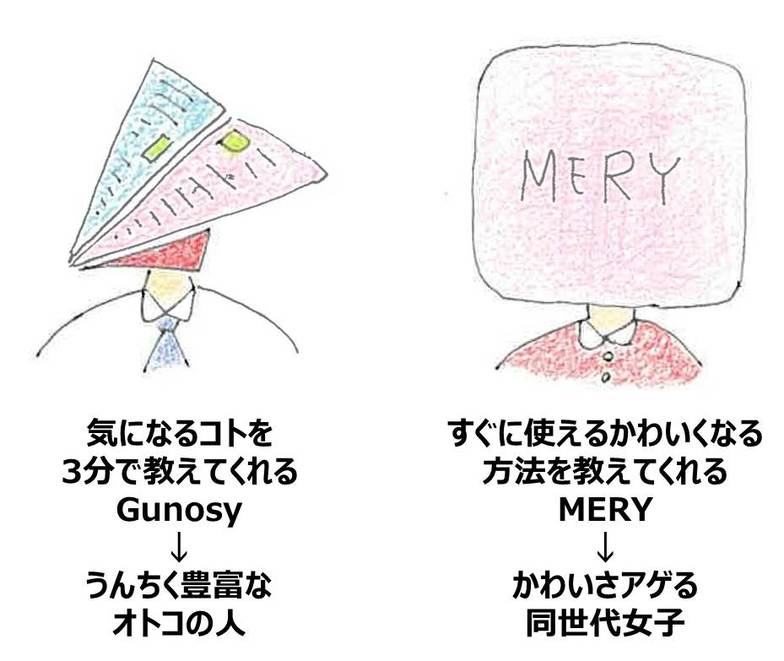
6.6 Affinity for Media
Smartphone users interact with media platforms much like they communicate with people. Consequently, users only engage with media they genuinely like. If a platform fails to feel like a distinct personality relevant to the user, interactions dwindle. The rise of self-curation means media platforms are organized much like friends are organized on LINE. For example, MERY is like a "girlfriend who's super into getting cute," consciously aware of its users and actively chatting with them about ways to become more adorable. Just like developing affection for an Instagrammer, the more frequently people use a media outlet, the more they develop affection for its character.
6.7 Who is saying?
Even if a media outlet reliably reaches a specific demographic, it won't elicit reader response or empathy—it'll be ignored—unless it speaks to readers through its unique character.6. Not only MERY, cited in points 5 and 6.6, but for any personified media, providing content through communication that feels authentic to that media is especially crucial. While "What to Say" and "How to Say" remain important in ad planning, the smartphone era demands a focus on "Who is Saying?"—clearly defining the personality behind the message. This requires consciously engaging in conversation with people who have a positive connection to each specific media.
7.The Deciding Factors in Purchase: "Knowledge = Interest" and "Conviction Over Desire"
7.1. Is it interest exploration, or is it interest sparked by something that caught their eye?
Whether latent or explicit, interest is what makes something catch the eye, prompting clicks to subsequent pages or searches. Users scan media and SNS; when intriguing information appears, their sensors activate, allowing immediate access to desired details.

And even if the understanding gained there is superficial or summarized, it counts as knowledge. People increasingly hold strong interest even with shallow knowledge and express themselves in contexts where they resonate more easily through quotes than their own words. When asked about a product they "like," people often describe it using comparisons like "something like XX" or adjectives like "super cute" or "insane." In other words, while "knowing" has become highly superficial, we only seek to know things that catch our attention in the first place. Thus, even this superficial "knowing" happens at a point where interest is already firmly established.
7.2 Key Factors in Purchase Decisions
So, do people actually buy the things they're interested in? The points that influence purchasing decisions can be categorized into the following four patterns.
① Things you can get by without buying
⇒ You want it, but it's not a necessity.
② Items that facilitate communication
⇒ Everyone has it; necessary for conversation.
③ Items you've decided to buy
⇒Not immediately needed, so buy when it's a good deal.
④ Things you can't know without buying
⇒ You can't gain real experience without paying.
Most things that spark interest fall into category ①. Naturally, ① doesn't lead to purchase. Items that lead to purchase fall into either ② to ④.
7.3. The "Sense of Conviction" That Influences Purchases
What ultimately determines a purchase is whether you can achieve a sense of conviction based on some reason. Among smartphone users, "self-convincing consumption" is increasing—where they verify the accuracy and volume of information received while progressing from "wanting" to "buying," gaining that sense of conviction along the way. In certain domains, specific conviction patterns have been established. For example, with clothing, "sale," "limited edition," and "only a few left" create the conviction to buy. Furthermore, demand is growing for "experience-based conviction"—where conviction can only be gained through the actual consumption experience itself—such as camping, festivals, theme parks, and movies.
Reference: The Key to Selling Goods via Smartphone Lies in "Self-Convincing Purchases"!?[2016.04.19]
7.4 New Purchasing Behavior
In the past, the overall number of products was smaller, and the desire to own things was strong. However, in modern times, while people want to shop, buying without a reason is rarely seen. Smartphone users are now searching for reasons to "buy with conviction" – reasons like exclusivity, discounts, trust, or trends. And by gaining that sense of conviction, they ultimately engage in purchasing behavior that increases their satisfaction with the purchase.

Summary
For about 20 years since my previous job, I've been involved in the mobile field. Now, smartphones, the symbol of mobile, have become firmly established in real life. Smartphones are becoming personalized for each individual, optimized according to the user's specific sensors, and the environment for utilizing them in communication is also becoming well-established. I believe that going forward, the use of smartphones will become extremely important for most communication, and I've outlined the key points for achieving effectiveness up to this point.
"What mechanisms capture people's attention? Which sensors trigger responses? What kind of characters and content should be used for communication?"
Moving forward, I want to continue exploring not only key points for utilizing smartphones in communication, but also how smartphone usage can contribute to business success.
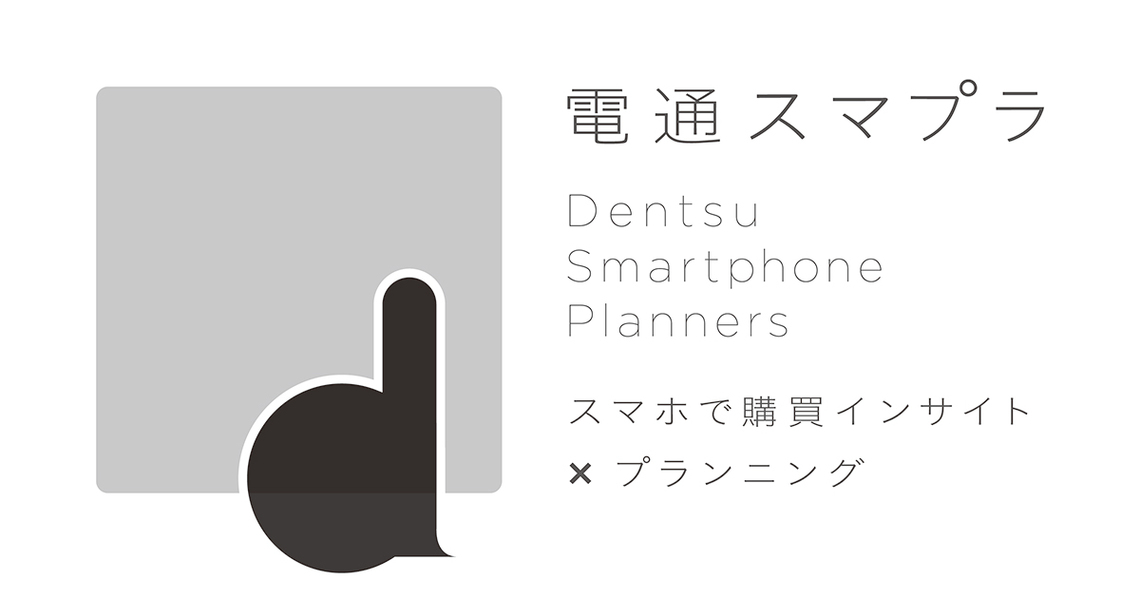
◎ What is "Dentsu Inc. Smartpla"?
It is a planning unit that contributes to launching, growing, and expanding businesses on smart devices (such as smartphones, PCs, and tablets).
Our team includes diverse professionals such as strategic planners, communication planners, consultants, copywriters, and producers, all with extensive experience in marketing communications for smartphone games and apps. Furthermore, as each member possesses a deep passion for specific fields, we support marketing activities by not only delving deeply into challenges but also engaging clients with our unique personalities and human skills.
Was this article helpful?
Newsletter registration is here
We select and publish important news every day
For inquiries about this article
Back Numbers
Author

Kentaro Yoshida
Dentsu Inc.
Solution Creation Center / Future Business Creation Research Founder
Chief Director, Marketing Division 4
Engaged in market analysis, strategic planning, and consulting primarily focused on the mobile business and smartphone app sector. As Dentsu Inc.'s Mobile Project Leader, attended CES/MWC annually since 2011 to grasp tech trends. Established the Dentsu Group cross-organizational "Future Business Creation Lab" in 2021. Specializes in business development through backcasting from visualizing future lifestyles. Fellow of the Consumer Affairs Agency's New Future Vision Forum; Master of Business Administration (MBA).
Articles by this person

Deepening discussions about the future through 'Dentsu Inc. Future Mandala 2025.' What kind of future will be woven by the diversifying concepts of 'connection' and 'abundance'?


